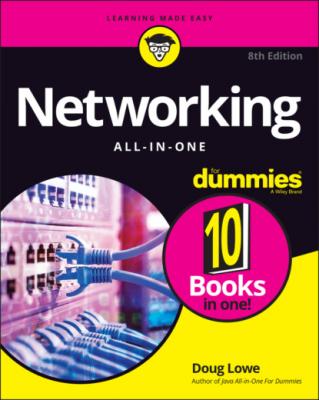Networking All-in-One For Dummies. Doug Lowe
Читать онлайн.| Название | Networking All-in-One For Dummies |
|---|---|
| Автор произведения | Doug Lowe |
| Жанр | Зарубежная компьютерная литература |
| Серия | |
| Издательство | Зарубежная компьютерная литература |
| Год выпуска | 0 |
| isbn | 9781119689058 |
The presentation layer
The presentation layer is responsible for how data is represented to applications. The most common representation for representing character data today is called UTF-8, which uses 8-bit sets to represent most characters found in western alphabets. UTF-8 is compatible with an older standard called ASCII.
Besides simply converting data from one code to another, the presentation layer can also apply sophisticated compression techniques so that fewer bytes of data are required to represent the information when it’s sent over the network. At the other end of the transmission, the presentation layer then decompresses the data.
The presentation layer can also scramble the data before it’s transmitted and then unscramble it at the other end by using a sophisticated encryption technique that even Sherlock Holmes would have trouble breaking.
The application layer
The highest layer of the OSI model, the application layer deals with the techniques that application programs use to communicate with the network. The name of this layer is a little confusing. Application programs (such as Microsoft Office or QuickBooks) aren’t a part of the application layer. Rather, the application layer represents the programming interfaces that application programs use to request network services.
Some of the better-known application layer protocols are
Domain Name System (DNS): For resolving Internet domain names
File Transfer Protocol (FTP): For file transfers
Simple Mail Transfer Protocol (SMTP): For email
Server Message Block (SMB): For file sharing in Windows networks
Network File System (NFS): For file sharing in Unix networks
Telnet: For terminal emulation
Following a Packet through the Layers
Figure 1-5 shows how a packet of information flows through the seven layers as it travels from one computer to another on the network. The data begins its journey when an end-user application sends data to another network computer. The data enters the network through an application layer interface, such as SMB. The data then works its way down through the protocol stack. Along the way, the protocol at each layer manipulates the data by adding header information, converting the data into different formats, combining packets to form larger packets, and so on. When the data reaches the physical layer protocol, it’s placed on the network media (in other words, the cable) and sent to the receiving computer.
When the receiving computer receives the data, the data works its way up through the protocol stack. Then, the protocol at each layer reverses the processing that was done by the corresponding layer on the sending computer. Headers are removed, data is converted back to its original format, packets that were split into smaller packets are recombined into larger messages, and so on. When the packet reaches the application layer protocol, it’s delivered to an application that can process the data.
FIGURE 1-5: How data travels through the seven layers.
The Ethernet Protocol
As I mention earlier, the first two layers of the OSI model deal with the physical structure of the network and the means by which network devices can send information from one device on a network to another. By far, Ethernet is the most popular set of protocols for the physical and data link layers.
Ethernet has been around in various forms since the early 1970s. (For a brief history of Ethernet, see the sidebar, “Ethernet folklore and mythology.”) The current incarnation of Ethernet is defined by the 802.3 IEEE standard. Various flavors of Ethernet operate at different speeds and use different types of media. However, all the versions of Ethernet are compatible with each other, so you can mix and match them on the same network by using devices such as bridges, hubs, and switches to link network segments that use different types of media.
Standard Ethernet: 10 Mbps; rarely (if ever) used today.
Fast Ethernet: 100 Mbps; still used for devices where speed is not particularly important, such as printers or fax machines.
Gigabit Ethernet and beyond: 1,000 Mbps; the most common speed used to connect user computers to a network. Faster speeds, such as 10 Gbps, 100 Gbps, and even faster, are sometimes used in high-speed networks to connect servers and other critical devices to the network.
Ethernet operates at the first two layers of the OSI model — the physical and the data link layers. However, Ethernet divides the data link layer into two separate layers: the Logical Link Control (LLC) layer and the Medium Access Control (MAC) layer. Figure 1-6 shows how the various elements of Ethernet match up to the OSI model.
FIGURE 1-6: Ethernet and the OSI model.
The following sections describe Standard Ethernet, Fast Ethernet, and Gigabit Ethernet in more detail.
Standard Ethernet
Standard Ethernet is the original Ethernet. It runs at 10 Mbps, which was considered fast in the 1970s but is excruciatingly slow by today’s standards. Although plenty of existing Standard Ethernet is still in use, it’s considered obsolete and should be replaced by Gigabit Ethernet as soon as possible.
Standard Ethernet came in three incarnations, depending on the type of cable used to string the network together:
10Base5: This original Ethernet cable was thick (about as thick as your thumb), heavy, and difficult to work with. It’s seen today only in museum exhibits.
10Base2:
